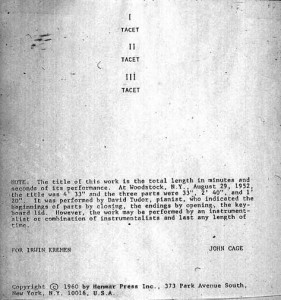 Today’s post is written by Geoff Twigg, Adjunct Professor at North Park University in Chicago. Geoff is a pastor, singer/songwriter, worship leader and ministry consultant, and serves the ECC as a member of the denomination’s Commission on Worship.
Today’s post is written by Geoff Twigg, Adjunct Professor at North Park University in Chicago. Geoff is a pastor, singer/songwriter, worship leader and ministry consultant, and serves the ECC as a member of the denomination’s Commission on Worship.
Last week, some of us celebrated a centenary. September the fifth was the birthdate of John Cage, a composer of music and a considerable influence on art in general during his long life. He died in 1992 but his reputation has grown, if anything, and he continues to be talked about and considered by the world of “art music”.
Cage was often bold in creating music that made one think. He took the lead in creating musical processes, and the systems which ran inside his music were quite audible and predictable. Some of it is very beautiful, and some quite obscure. One of the pieces Cage ‘wrote’, probably his best known, is a silent piece (for any instrument or group) called 4’33” (pronounced “Four Minutes, Thirty Three Seconds”). I won’t bore you with the details, but it’s part of a musical philosophy called automaticism, heavily influenced by Zen Buddhism, and the ‘piece’ really consists of the ambient sounds you hear while the instruments are not playing.
I’m quite sure that 4’33” will not become a popular choice for Special Music in our worship services. Of course, there are many reasons for this, but the one I want to point out today is that we need to find the art in our services useful, or we can’t really justify it.
We use music to accompany singing, or to cover ‘gaps’ which would otherwise be silent. Or to mask the sound of people walking among us with collection baskets and communion trays. We use pictorial art for bulletin covers and sermon illustrations. We use drama to reinforce our teaching or make people think about a moral dilemma. We use sculpture mostly in memorials or to mark graves. We use architecture to make the building more flexible and useful as a banqueting hall or sports environment, because these days we can’t seem to justify spending money on sacred space.
Looking back on many years in the Evangelical tradition, I can think of very few examples of art, of any form, that was employed for its own value. Of course (back in the day) we had Warner Sallman’s art which I personally enjoy. Walking through churches I often see pictures and statuettes that remain, remembered but hardly ever featured, because they were a gift from a member or a favorite of a previous incumbent.
And so we come to silence. Calculated and scored, like Cage’s work, or announced (maybe even justified?) “because we’re thinking about Psalm 46”. Silence may be golden, but it’s not useful.
Thinking just a little more about this, I’d love for us to revisit Exodus chapters 35 through 39. While the objects that were created were undoubtedly useful and justifiable, there seems to be an extraordinary amount of sheer art going on. God seems to have required it of his people, and encouraged them to employ the artists to create art, to train up younger artisans and generally beautify the whole place. What does this mean? Can God really value art for its own sake?
Then of course, there are those moments – highlights – high and holy moments, throughout the Bible where the presence of God is tangibly felt; in silence. Not Cage’s timed, framed silence, but the eternal silence of the ages, of true stillness.
Not useful, but golden nevertheless.

